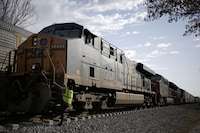A potential rail strike is back on the table Monday on word that one of the largest unions rejected a hard-fought contract offer.
Everything you need to know about the threat of a rail strike

Freight railroad companies and their affiliated unions had been locked in a dispute over pay and working conditions for months, but the threat of a strike eased in September after President Biden announced a “tentative” deal had been reached to avoid a major economic disruption. But now several rail unions have rejected their contracts in recent weeks, bringing the fear of a strike to the forefront.
A strike would affect not only commuters who rely on the railway to get to work but also the nation’s energy supply and drinking water.
A strike was narrowly avoided in September when Labor Secretary Marty Walsh held emergency meetings with the rail carriers and unions overnight to help broker a deal. Disruptions were already being felt: Amtrak announced it would cancel some of its long-distance trains starting Thursday, and other rail systems braced for shutdowns. Amtrak resumed normal service after the strike was averted.
The impasse was tied to disagreements between management and labor over sick time and penalties for missing work, a politically challenging stalemate for Biden, who has vowed to be the nation’s “most pro-union president” but has prioritized untangling its besieged infrastructure in the covid-19 era.
Here’s what you need to know about the dispute.






